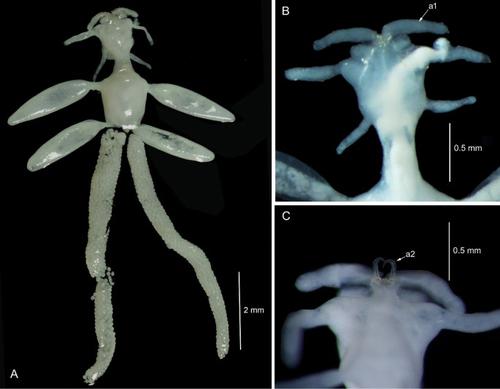Acta Parasitologica ( IF 1.5 ) Pub Date : 2024-03-11 , DOI: 10.1007/s11686-024-00820-3 Panakkool Thamban Aneesh , Susumu Ohtsuka , Yusuke Kondo , Ameri Kottarathil Helna

|
Purpose
The present paper describes two new genera and species of the parasitic copepod family Chondracanthidae Milne Edwards, 1840 based on specimens collected from two species of deep-sea fishes at a depth of 212 m off Suruga Bay, Japan. Avatar nishidai gen. et sp. nov. is described from the host fish Chaunax abei Le Danois, 1978 (Chaunacidae). Kokeshioides surugaensis gen. et sp. nov. is described from the host fish Setarches longimanus (Alcock, 1894) (Setarchidae).
Methods
Fresh specimens of chondracanthids were collected from the buccal cavity of two species of deep-sea fishes (fish hosts were frozen), Chaunax abei Le Danois, 1978 (Lophiiformes: Chaunacidae) and Setarches longimanus (Alcock, 1894) (Perciformes: Setarchidae), caught at a depth of 212 m in Suruga Bay, Japan (34° 37′48.87″ N, 138° 43′2.958″ E). Both the species are described and illustrated based on ovigerous females.
Results
The genus Avatar gen. nov. can readily be distinguished from all other chondracanthid genera by the following combination of features: cephalothorax slightly wider than long with anterior pair of large and posterior pair of small lateral lobes, and two pairs of ventro-lateral processes; the very posteriormost part of the first pedigerous somite contributes to the neck; cylindrical trunk with two pairs of blunt proximal fusiform processes; antennule with small knob terminally; antenna bearing distal endopodal segment; labrum protruding ventrally; two pairs of biramous legs each with 2-segmented rami. Kokeshioides gen. nov. has the following combinations of features that distinguish it from other chondracanthid genera: body flattened, without lateral processes; cephalothorax much wider than long, with paired anterolateral and posterolateral lobes, folded ventrally; the very posteriormost part of the first pedigerous somite contributes to the neck; mandible elongate; legs unique, heavily sclerotized, represented by two pairs of acutely pointed processes.
Conclusion
With the addition of two new genera presently reported, the family Chondracanthidae currently includes 52 valid genera. Among the described genera Avatar gen. nov. seems to be very primitive, while Kokeshioides gen. nov. is highly advanced. The deduced evolutionary history of chondracanthid genera is also discussed.
中文翻译:

来自日本骏河湾深海鱼类的寄生桡足类软骨棘科的两个新属和新种 Milne Edwards,1840 年(桡足类:Cyclopoida)
目的
本文根据从日本骏河湾 212 m 深处的两种深海鱼类采集的标本,描述了寄生桡足类软骨鱼科 Milne Edwards, 1840 的两个新属和新种。阿凡达 西代 gen. 等 十一月 是从宿主鱼Chaunax abei Le Danois, 1978 (Chaunacidae) 中描述的。Kokeshioides surugaensis gen. 等 十一月 是从寄主鱼Setarches longimanus (Alcock, 1894) (Setarchidae) 中描述的。
方法
软骨棘鱼的新鲜标本是从两种深海鱼类(鱼类宿主被冷冻)的口腔中采集的,Chaunax abei Le Danois, 1978(Lophiiformes:Chaunacidae)和Setarches longimanus(Alcock,1894)(Perciformes:Setarchidae),在日本骏河湾 212 m 深处(北纬 34° 37′48.87”,东经 138° 43′2.958”)捕获。这两个物种都是基于产卵雌性进行描述和说明的。
结果
阿凡达 gen 属。十一月 通过以下特征组合,可以很容易地将其与所有其他软骨棘鱼属区分开来:头胸部稍宽于长,具有前对大侧叶和后对小侧叶,以及两对腹侧突;第一个幼体体节的最后部分构成颈部;圆柱形主干,有两对近端钝的梭形突起;触角末端有小旋钮;天线承载远端内足段;盂唇向腹侧突出;两对双腿,各有 2 节支。Kokeshioides gen. 十一月 具有以下特征组合,使其与其他软骨棘科属区别开来:身体扁平,没有侧突;头胸部宽度远大于长度,具有成对的前外侧叶和后外侧叶,向腹侧折叠;第一个幼体体节的最后部分构成颈部;下颌骨伸长;腿独特,严重硬化,以两对尖锐的突起为代表。
结论
随着目前报道的两个新属的增加,软骨棘科目前包括 52 个有效属。在所描述的属阿凡 达一代中。十一月 似乎很原始,而Kokeshioides gen。十一月 是非常先进的。还讨论了软骨棘鱼属的推论进化历史。



























 京公网安备 11010802027423号
京公网安备 11010802027423号